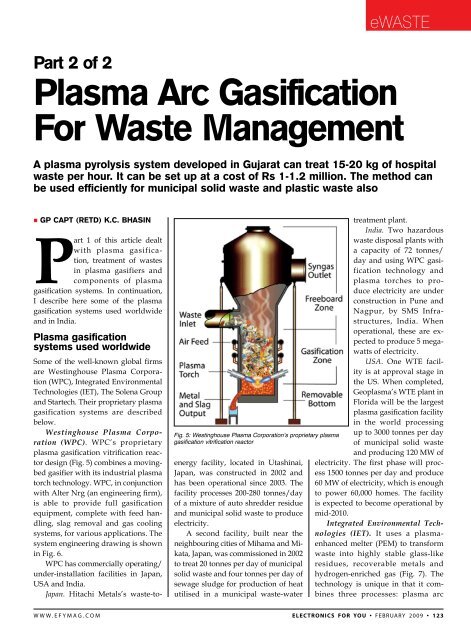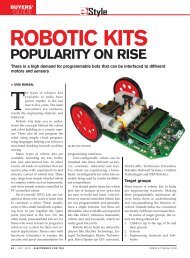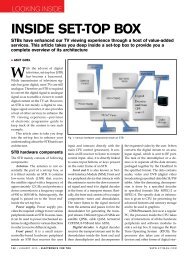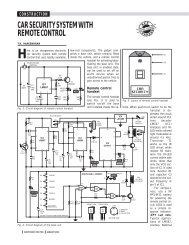Plasma Arc Gasification For Waste Management - Electronics For You
Plasma Arc Gasification For Waste Management - Electronics For You
Plasma Arc Gasification For Waste Management - Electronics For You
Create successful ePaper yourself
Turn your PDF publications into a flip-book with our unique Google optimized e-Paper software.
Part 2 of 2<br />
w w w . e F y m a g . c o m<br />
ewaste<br />
<strong>Plasma</strong> <strong>Arc</strong> <strong>Gasification</strong><br />
<strong>For</strong> <strong>Waste</strong> <strong>Management</strong><br />
A plasma pyrolysis system developed in Gujarat can treat 15-20 kg of hospital<br />
waste per hour. It can be set up at a cost of Rs 1-1.2 million. The method can<br />
be used efficiently for municipal solid waste and plastic waste also<br />
� GP CAPT (ReTd) K.C. BhAsIn<br />
Part 1 of this article dealt<br />
with plasma gasification,<br />
treatment of wastes<br />
in plasma gasifiers and<br />
components of plasma<br />
gasification systems. In continuation,<br />
I describe here some of the plasma<br />
gasification systems used worldwide<br />
and in India.<br />
<strong>Plasma</strong> gasification<br />
systems used worldwide<br />
Some of the well-known global firms<br />
are Westinghouse <strong>Plasma</strong> Corporation<br />
(WPC), Integrated Environmental<br />
Technologies (IET), The Solena Group<br />
and Startech. Their proprietary plasma<br />
gasification systems are described<br />
below.<br />
Westinghouse <strong>Plasma</strong> Corporation<br />
(WPC). WPC’s proprietary<br />
plasma gasification vitrification reactor<br />
design (Fig. 5) combines a movingbed<br />
gasifier with its industrial plasma<br />
torch technology. WPC, in conjunction<br />
with Alter Nrg (an engineering firm),<br />
is able to provide full gasification<br />
equipment, complete with feed handling,<br />
slag removal and gas cooling<br />
systems, for various applications. The<br />
system engineering drawing is shown<br />
in Fig. 6.<br />
WPC has commercially operating/<br />
under-installation facilities in Japan,<br />
USA and India.<br />
Japan. Hitachi Metals’s waste-to-<br />
Fig. 5: Westinghouse <strong>Plasma</strong> Corporation’s proprietary plasma<br />
gasification vitrification reactor<br />
energy facility, located in Utashinai,<br />
Japan, was constructed in 2002 and<br />
has been operational since 2003. The<br />
facility processes 200-280 tonnes/day<br />
of a mixture of auto shredder residue<br />
and municipal solid waste to produce<br />
electricity.<br />
A second facility, built near the<br />
neighbouring cities of Mihama and Mikata,<br />
Japan, was commissioned in 2002<br />
to treat 20 tonnes per day of municipal<br />
solid waste and four tonnes per day of<br />
sewage sludge for production of heat<br />
utilised in a municipal waste-water<br />
treatment plant.<br />
India. Two hazardous<br />
waste disposal plants with<br />
a capacity of 72 tonnes/<br />
day and using WPC gasification<br />
technology and<br />
plasma torches to produce<br />
electricity are under<br />
construction in Pune and<br />
Nagpur, by SMS Infrastructures,<br />
India. When<br />
operational, these are expected<br />
to produce 5 megawatts<br />
of electricity.<br />
USA. One WTE facility<br />
is at approval stage in<br />
the US. When completed,<br />
Geoplasma’s WTE plant in<br />
Florida will be the largest<br />
plasma gasification facility<br />
in the world processing<br />
up to 3000 tonnes per day<br />
of municipal solid waste<br />
and producing 120 MW of<br />
electricity. The first phase will process<br />
1500 tonnes per day and produce<br />
60 MW of electricity, which is enough<br />
to power 60,000 homes. The facility<br />
is expected to become operational by<br />
mid-2010.<br />
Integrated Environmental Technologies<br />
(IET). It uses a plasma-<br />
enhanced melter (PEM) to transform<br />
waste into highly stable glass-like<br />
residues, recoverable metals and<br />
hydrogen-enriched gas (Fig. 7). The<br />
technology is unique in that it combines<br />
three processes: plasma arc<br />
electronics for you • F e b rua ry 2 0 0 9 • 123
ewaste<br />
Fig. 6: Alter Nrg plasma gasification system using WPC PGVR<br />
Fig. 7: Schematic of PEM process vessel with side-entry AC electrodes<br />
using multiple graphite electrodes,<br />
joule (resistance) heating using glass<br />
melter technology and superheated<br />
steam. This combination results in a<br />
stable and highly controllable treatment<br />
system.<br />
The plasma operates at temperatures<br />
from 3000°C to 10,000°C in an<br />
oxygen-free environment with the<br />
presence of superheated steam ensuring<br />
that pyrolysis and steam reforming<br />
reactions dominate. A high-efficiency<br />
scrubber is used to remove volatile<br />
metals and other pollutants from<br />
the hydrogen-rich product gas (100<br />
BTU/scf or more), a portion of which<br />
may be recycled to provide power<br />
to the PEM and<br />
the other portion<br />
used to generate<br />
electricity.<br />
Metals in the<br />
waste are recovered.<br />
The glassy<br />
aggregate is also<br />
recovered and<br />
may be recycled<br />
as road building,<br />
blasting grit<br />
or construction<br />
material. Volume<br />
reductions are up<br />
to 98 per cent depending<br />
on how<br />
the process is run<br />
and the composition of the waste.<br />
IET is more interested in treating<br />
radioactive, hazardous, industrial, municipal,<br />
tire, incinerator ash and medical<br />
waste streams. It has sold several<br />
commercial PEM units throughout the<br />
world to process a wide range of waste<br />
materials. <strong>For</strong> details, visit ‘www.inentec.com/commercial.html.’<br />
The Solena Group. The Solena<br />
Group, a strategic partner of Westinghouse,<br />
uses the integrated plasma<br />
gasification combined cycle (IPGCC).<br />
It is a unique process that uses a<br />
patented plasma gasification vitrification<br />
(PGV) technology for conversion<br />
of low-value fuels/feed stocks<br />
(such as coal waste, petroleum coke,<br />
bio-mass and different waste forms<br />
including municipal solid waste)<br />
into a low-heating-value synthesis or<br />
syngas containing carbon monoxide<br />
and hydrogen gases. This gas is then<br />
employed as a primary fuel for a gas<br />
turbine.<br />
The IPGCC can also be viewed as<br />
a two-stage processor of an opportunity<br />
feedstock. The feedstock is first<br />
gasified (partially oxidised) in a gasifier<br />
using high-temperature plasma<br />
heating systems at atmospheric<br />
pressure. The gas is then cleaned and<br />
combusted (completely oxidised) in<br />
the gas turbine to produce electricity.<br />
The PGV reactor, in essence, cleans<br />
the solid/liquid and/or dirty fuels/<br />
feed stocks by converting them into a<br />
valuable byproduct fuel gas or syngas<br />
to power a gas turbine.<br />
The IPGCC system generally<br />
consists of four separate processes:<br />
feedstock handling, plasma gasification<br />
and vitrification, gas cooling and<br />
clean-up, and gas turbine combined<br />
cycle.<br />
The IPGCC system offers significant<br />
advantages over standard IGCC.<br />
By applying the PGV technology for<br />
gasifying the feedstock, the plasma<br />
heating system provides an independent<br />
and extremely powerful heating<br />
1 2 6 • Februa ry 2 0 0 9 • electronics for you w w w . e F y m a g . c o m
Fig. 8: Schematic of integrated plasma gasification combined cycle (IPGCC) process<br />
Fig. 9: Startech’s plasma converter system<br />
source at atmospheric pressure, allowing<br />
the gasifier system to be fuel-flexible,<br />
have high availability for base<br />
load power, achieve higher efficiency,<br />
and provide lower operation and<br />
maintenance costs.<br />
The PGV reactor employs plasma<br />
torches to heat the reactor to 4000-<br />
w w w . e F y m a g . c o m<br />
5000°C at atmospheric pressure. At<br />
this operating temperature, the PGV<br />
process uses a carbon-based catalyst<br />
and oxygen-enriched air to cause the<br />
hydrocarbon or organic material to<br />
undergo partial oxidation, i.e., the hydrocarbon<br />
material is depolymerised<br />
into carbon and hydrogen molecules<br />
ewaste<br />
by the plasmagenerated<br />
heat<br />
and undergoes<br />
partial oxidation<br />
to be released as a<br />
mixture of H 2 and<br />
CO. The syngas<br />
has a heating value<br />
of about onethird<br />
to one-sixth<br />
of natural gas. All<br />
inorganic or nonh<br />
y d r o c a r b o n -<br />
based materials in<br />
the feedstock are<br />
simultaneously<br />
vitrified into an<br />
inert glassy slag,<br />
suitable for use as<br />
construction materials<br />
including<br />
aggregates, tiles<br />
or bricks.<br />
The IPGCC<br />
system uses General<br />
Electric’s LCV<br />
gas turbines. The<br />
process is shown<br />
in Fig. 8.<br />
Utilising biomass<br />
as a fuel<br />
source, Solena’s<br />
technology can be<br />
used anywhere<br />
in the world.<br />
Presently, plants<br />
based on Solena’s<br />
IPGCC technology<br />
are operational<br />
in North America,<br />
the Caribbean,<br />
Europe and South<br />
America.<br />
Solena Group’s<br />
ongoing projects<br />
include:<br />
1. Five 40MW renewable energy<br />
plants in California<br />
2. A renewable energy plant for a<br />
hazardous waste management group<br />
in Europe to turn solid and liquid<br />
waste into clean energy<br />
3. Two 90MW renewable energy<br />
plants for two major European cities<br />
electronics for you • F e b rua ry 2 0 0 9 • 127
ewaste<br />
Fig. 10: Schematic of plasma pyrolysis system (courtesy: www.plasmaindia.com)<br />
Startech. Startech’s plasma<br />
gasification uses extremely highenergy<br />
plasma (at a temperature of<br />
16,649°C, which is three times as<br />
hot as the surface of the Sun). The<br />
plasma torch inside the containment<br />
vessel is directed by an operator to<br />
break down whatever material is fed<br />
into it. It acts much like contained,<br />
continuous lightning, and everything<br />
that is fed into the system is<br />
broken down into its constituent<br />
atoms. Because the plasma torch so<br />
thoroughly annihilates anything that<br />
is fed into it, it is also an excellent<br />
means of dealing with dangerous<br />
and hazardous waste. The system is<br />
called a closed-loop elemental recycling<br />
system.<br />
Startech’s plasma converter system<br />
is shown in Fig. 9. First, the trash<br />
is fed into an auger that shreds it<br />
into small pieces. Then the mulch is<br />
delivered into the plasma chamber,<br />
where the superheated plasma converts<br />
it into two byproducts. One is<br />
a plasma-converted gas (PCG). Also<br />
called syngas, it is composed mostly<br />
of hydrogen and carbon monoxide,<br />
and is fed into the adjacent Starcell<br />
patented system for conversion into<br />
fuel. The other byproduct is molten<br />
glass, which can be sold for use in<br />
household tiles or road asphalt.<br />
Joseph Longo, CEO of Startech<br />
Environmental Corporation, USA,<br />
claimed that his plasma converter<br />
could turn the most vile and toxic trash<br />
into clean energy—and promised to<br />
make a relic of the landfill. An article<br />
on the same appeared in March 2007<br />
issue of Popular Science magazine under<br />
the title ‘The Prophet of Garbage.’ The<br />
same can be viewed at ‘www.popsci.<br />
com/scitech/article/2007-03/prophetgarbage’<br />
Startech’s current and future installations<br />
include those in Japan and<br />
South Carolina, USA. The plasma<br />
converter system installed in Japan can<br />
process five tonnes per day of hazardous<br />
incinerator ash. A joint project with<br />
ViTech Enterprises to manufacture and<br />
install a 10-tonne-per-day plasma converter<br />
facility to destroy out-of-date<br />
pharmaceutical products is in progress<br />
in South Carolina, USA.<br />
The company’s negotiations with<br />
various bodies throughout the world<br />
are at various stages of progress.<br />
Indian scenario<br />
In India, about 30 million tonnes of<br />
municipal solid waste and about 4400<br />
million cubic metres of liquid waste<br />
are generated annually. The municipal<br />
sold waste generation ranges from<br />
0.25 to 0.75 kg/day per capita with<br />
an average of 0.45 kg/day per capita.<br />
In addition, large quantities of solid<br />
and liquid wastes are generated by the<br />
industry.<br />
Most of the generated wastes find<br />
their way into land and water bodies<br />
without proper treatment, causing<br />
severe water pollution. These also<br />
emit greenhouse gases like methane<br />
and carbon dioxide, adding to air<br />
pollution.<br />
There exists a potential for generating<br />
an estimated 1700 MW of<br />
power from the urban and municipal<br />
wastes, and about 1000 MW from<br />
industrial wastes in the country. The<br />
1 2 8 • Februa ry 2 0 0 9 • electronics for you w w w . e F y m a g . c o m
during the quenching proc-<br />
Emissions From the Exhaust of<br />
ess. The entire process takes<br />
FCIPT’s <strong>Plasma</strong> Pyrolysis System place in the absence of oxygen.<br />
The system can treat 15-<br />
20 kg of hospital waste per<br />
hour. It can be set up at a<br />
cost of Rs 1-1.2 million. The<br />
plasma pyrolysis method<br />
can be used efficiently for<br />
municipal solid waste and<br />
plastic waste also. The gas product<br />
has a heating value of approximately<br />
one-third the heating value of natural<br />
gas. Therefore it can be used as an<br />
efficient fuel source for industrial<br />
processes, including electricity generation<br />
and production of methanol<br />
and ethanol. The slag can be used in<br />
the construction industry or for road<br />
paving. <strong>Plasma</strong> discharge treatment<br />
has no byproducts which must be<br />
disposed of as waste. Therefore it can<br />
be viewed as a totally closed treatment<br />
system. The plasma pyrolysis<br />
system is shown in Fig. 10.<br />
Four systems have been supported<br />
by the Department of Science and<br />
Technology for field installations for<br />
plastic/municipal waste disposal,<br />
focusing on the demonstration in ecologically<br />
sensitive regions.<br />
Meanwhile, Bhabha Atomic Research<br />
Centre (BARC) has provided<br />
technology for conversion of kitchen<br />
wastes, stale food, split milk, leftovers<br />
from hotels and vegetable refuge into<br />
organic manure, offering excellent<br />
topsoil material to the farmers. A<br />
few such plants have already been<br />
installed in Maharashtra, Orissa and<br />
Gujarat.<br />
Similarly, Mumbai-based Asian<br />
<strong>Electronics</strong> Ltd and Singapore’s Enviro-Hub<br />
Holdings have teamed up to<br />
build four power plants of 8 MW each<br />
using a commercially viable technology<br />
for producing electricity from<br />
plastic waste.<br />
Here are the excerpts of an e-mail<br />
posted by Hareesh Iddya of Indian<br />
Institute of Science (IISc), Bangalore,<br />
on May 4, 2007 on ‘Down to<br />
Earth’ website, which show some<br />
Pollutant CPCB Standard* <strong>Plasma</strong> System<br />
CO 100 mg/Nm 3 40-85 mg/Nm 3<br />
NOx 400 mg/Nm 3 7-25 mg/Nm 3<br />
PM 150 mg/Nm 3 31-105 mg/Nm 3<br />
Dioxin & Furan 0.1 ng/Nm 3 TEQ 0.1 ng/Nm 3 TEQ<br />
*Central Pollution Control Board’s emission standards<br />
Source: www.plasmaindia.com<br />
potential is likely to increase further<br />
with economic development.<br />
Indian domestic wastes contain<br />
60-80 per cent moisture and 70-80 per<br />
cent biodegradables and 7-10 per cent<br />
combustibles by wet weight. In comparison,<br />
in the West, with relatively<br />
dry wastes, the reverse is true: They<br />
contain 16-24 per cent biodegradables<br />
and the rest are mostly combustibles.<br />
Hence, burn technologies are unviable<br />
in India.<br />
<strong>Plasma</strong> gasification plants. Presently,<br />
there are two 68 tonnes-per-day<br />
hazardous waste disposal plants utilising<br />
the WPC’s PGVR technology. As<br />
mentioned earlier, these are being constructed<br />
at Pune and Nagpur by SMS<br />
Infrastructures Limited to produce 5<br />
MW of electricity.<br />
<strong>Plasma</strong> pyrolysis system designed<br />
by FCIPT. The Gujarat-based Facilitation<br />
Centre for Industrial <strong>Plasma</strong><br />
Technologies (FCIPT), which is a part<br />
of the Institute of <strong>Plasma</strong> Research,<br />
in collaboration with TIFAC of the<br />
Department of Science and Technology,<br />
has designed a plasma pyrolysis<br />
system.<br />
The torch (consisting of two electrode<br />
devices that convert electrical<br />
energy into heat energy) has also been<br />
developed by FCIPT. In the primary<br />
chamber, waste is fed and treated with<br />
plasma emitted by the torch. Thereafter,<br />
gases and slag are formed in the<br />
chamber. The gases include carbon<br />
monoxide, nitrogen and hydrocarbons.<br />
These are decontaminated (scrubbed)<br />
in the secondary chamber (with the<br />
help of a chemical/water shower).<br />
The temperature of the gases is also<br />
reduced from 600°C to less than 80°C<br />
w w w . e F y m a g . c o m<br />
ewaste<br />
electronics for you • F e b rua ry 2 0 0 9 • 129
ewaste<br />
demoralising effect on the efforts<br />
being put in by the Institute:<br />
“Scientists at the IISc, Bangalore,<br />
have been working on biomass gasification<br />
for more than 20 years. They<br />
have developed fully commercial technology<br />
for producing heat or power<br />
from wastes. Though the technology<br />
is being implemented in several industries,<br />
certain upstream R&D is still<br />
required to modify the technology for<br />
proper utilisation of refuse-derived<br />
fuel.<br />
“We were planning to try this<br />
technology through a pilot plant at a<br />
small town called Chitradurga where<br />
the estimated daily municipal solid<br />
waste production is 44 tonnes (15<br />
tonnes of combustible material). The<br />
plant involves processes like segregation,<br />
drying and pelletisation of<br />
municipal waste before gasification<br />
with about 220 kW of power production.<br />
Of this, about 50 kW was<br />
estimated for in-house consumption.<br />
Under the plan, the plant was to be<br />
set up on a landfill site spread over<br />
an area of 14 hectares on the outskirts<br />
of the town. The project had also<br />
received approval from Chitradurga<br />
municipality.<br />
“However, following a hullabaloo<br />
by well-intentioned environmentalists,<br />
the whole matter is now in a<br />
limbo.”<br />
Import of foreign technologies<br />
for waste management. We should<br />
wisely evaluate all pros and cons<br />
before adopting any imported technology.<br />
We must draw lesson from<br />
the costly blunder that was made<br />
in 1980’s while installing a Danishsupplied<br />
incinerator at Timarpur in<br />
Delhi at a cost of Rs 410 million that<br />
ran for only six days because of high<br />
inerts and ash in the waste supplied.<br />
India lost the case at Hague because<br />
‘suitable waste’ to be provided was<br />
not defined in the agreement. Current<br />
interest and caretaking costs<br />
have totaled a staggering Rs 2 billion<br />
or more. Even worse, this valuable<br />
waste-disposal site has been lost for<br />
decades to the city as the plant is<br />
neither being sold as scrap, nor are<br />
there any takers to take it over for<br />
operation.<br />
Assessing viability of the imported<br />
plasma gasification technology.<br />
<strong>For</strong> assessing the financial viability of<br />
the projects, especially those involving<br />
foreign firms like Startech, the<br />
operating cost, net cost of operation<br />
and capital cost should be taken into<br />
account.<br />
Operating cost. The electrical<br />
power requirement for conversion of<br />
one tonne of municipal solid waste<br />
into vitrified solids and metals, hydrogen<br />
and carbon monoxide gas<br />
averages around 670 units (kWh). At<br />
Rs 3 per unit, the cost of conversion<br />
works out to be Rs 2000 per tonne.<br />
Although one may be able to reduce<br />
the running cost by, say, 75 per cent,<br />
after selling the byproducts, the net<br />
cost of the plant would still be Rs 750<br />
per tonne.<br />
Net cost of operation. As an example,<br />
let us consider Delhi (not entire<br />
NCR) with its current population of<br />
over 15 million. The average garbage<br />
generation may be assumed to be<br />
0.7 kg per person per day (against<br />
Americans’ average of about 2 kg per<br />
person per day). Accordingly, Delhi<br />
would be generating around 10,500<br />
metric tonnes of garbage per day. The<br />
net operational cost would thus be Rs<br />
7.875 million per day (at Rs 750 per<br />
tonne) or Rs 2870 million per annum.<br />
This is in addition to garbage collection<br />
and transportation and other<br />
infrastructure costs.<br />
Capital cost. A Startech plasma<br />
converter that could handle 2000<br />
tonnes of waste daily costs roughly<br />
$250 million. Delhi would require<br />
eight such huge plants at a whopping<br />
cost of $1000 million (roughly Rs 40<br />
billion).<br />
India, being a labour-intensive<br />
country, should employ matching<br />
technologies by segregating the various<br />
types of wastes and treating each<br />
one using indigenously-developed<br />
appropriate technologies. �<br />
Concluded<br />
1 3 0 • Februa ry 2 0 0 9 • electronics for you w w w . e F y m a g . c o m








